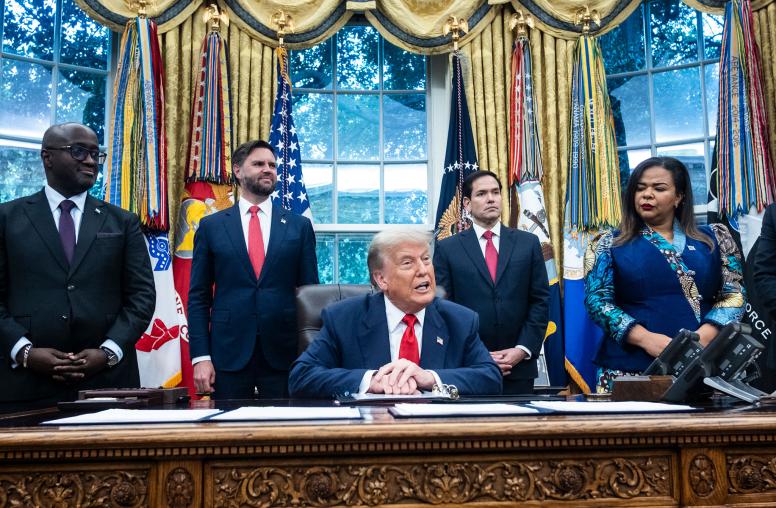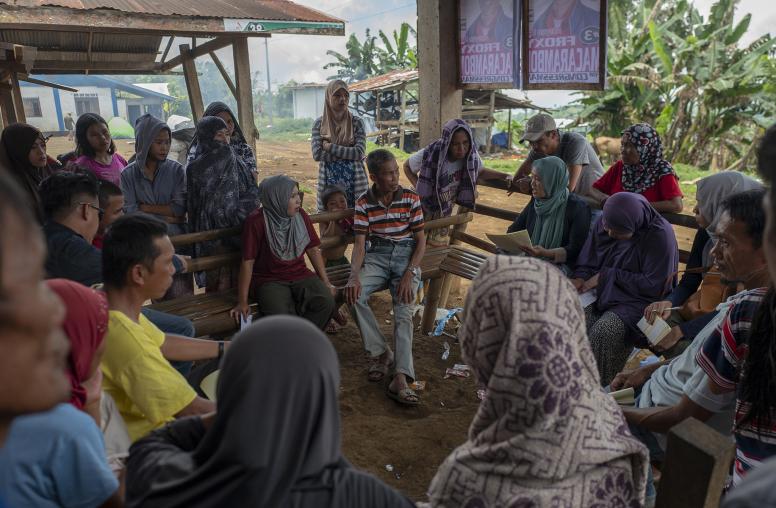Biosecurity: Limiting Terrorist Access to Deadly Pathogens
Peaceworks No. 52
In this Peaceworks report, current national and international efforts to prevent terrorists from acquiring dangerous pathogens and argues for the establishment of a set of global biosecurity standards are explored.

Summary
Long a hypothetical threat, bioterrorism became a harsh reality soon after September 11, 2001, when letters containing a refined preparation of dried anthrax spores were sent through the U.S. mail, infecting more than twenty people and killing five. Although the October 2001 anthrax attack was fortunately limited in scale, it hinted at the mayhem that could result from the deliberate release of "weaponized" disease agents.
In this Peaceworks report, Jonathan B. Tucker, a 2002-03 Jennings Randolph Senior Fellow at the U.S. Institute of Peace, explores current national and international efforts to prevent terrorists from acquiring dangerous pathogens and argues for the establishment of a set of global biosecurity standards.
Tucker was a United Nations Special Commission (UNSCOM) biological weapons inspector in Iraq in February 1995, and he directed the Chemical and Biological Weapons Nonproliferation Program at the Monterey Institute of International Studies' Center for Nonproliferation Studies (CNS) from 1996 to 2002. He is currently a senior researcher at the CNS office in Washington, D.C. Before joining the center, he was a specialist on chemical and biological arms control at the United States Arms Control and Disarmament Agency and the congressional Office of Technology Assessment. His most recent book, Scourge: The Once and Future Threat of Smallpox (Atlantic Monthly Press, 2001), was selected as a "Best Book of the Year" by the Washington Post. During his fellowship at the U.S. Institute of Peace, Tucker researched prevention-oriented strategies for countering bioterrorism; his principal findings are presented in this Peaceworks report.
To date, most of the emphasis in countering bioterrorism has been on the medical and public health response to an attack, rather than on prevention. Tucker notes that while improved disease surveillance and medical countermeasures such as new drugs and vaccines are important, there should be an equal emphasis on reducing the risk of an attack. He begins by distinguishing between the concepts of biosafety and biosecurity. Whereas biosafety refers to measures to prevent the accidental release of pathogens, biosecurity involves measures that guard against the deliberate release of pathogens for malicious purposes; yet most national and international legislation to date has focused on biosafety and not biosecurity. In a belated effort to improve security at microbiological laboratories and biological suppliers after the September 11 terrorist attacks and the subsequent anthrax letter attacks, Congress passed two significant pieces of legislation (the USA PATRIOT Act and the Bioterrorism Preparedness Act) that tightened controls over dangerous pathogens and toxins stored, used, and transferred within the United States.
Nevertheless, according to Tucker, the international dimension of the biosecurity problem remains to be addressed. No uniform global standards for laboratory security currently exist on which individual states can base national legislation and regulations. This lack of harmonization, Tucker argues, has given rise to gaps and vulnerabilities that must be addressed as part of a coordinated global strategy to prevent bioterrorism.
The United States is just one of many countries that conduct research on infectious disease agents and maintain collections of dangerous pathogens. According to Tucker, one area of particular concern is the legacy of the Soviet offensive biological warfare program.
Today, many former bioweapons-related facilities--now located in the independent states of Russia and Kazakhstan--have been converted to civilian uses. Nevertheless, they continue to possess collections of highly dangerous pathogens that could potentially be stolen or diverted for military, terrorist, or criminal purposes. Although improved security for collections of dangerous pathogens in the former Soviet Union is urgently needed, many laboratories (such as those associated with the network of Anti-Plague Institutes and field stations) lack the necessary financial and technical resources to implement these measures.
Tucker cautions that the former Soviet Union is not the only area of concern. Several countries now operate maximum-containment (Biosafety Level-4) laboratories designed for work with the most dangerous and incurable pathogens. Security risks are also associated with roughly one-third of the fifteen hundred state-owned and commercial culture collections worldwide that possess, exchange, and sell samples of microorganisms and toxins for legitimate scientific and biomedical research. Culture collections vary widely in size and content--ranging from large organizations, such as the nonprofit American Type Culture Collection in Virginia and the U.S. Department of Agriculture's collection of plant and animal pathogens in Ames, Iowa, to small "boutique" collections of microbial strains at universities, federal agencies, and private companies. Numerous culture collections outside the United States are not adequately secured and controlled, making them potentially vulnerable to theft by proliferators and terrorists. In addition, trade in microbial cultures is poorly regulated, both within and among countries.
To address this problem, several countries in addition to the United States have passed legislation concerning laboratory security. Nevertheless, Tucker argues, national biosecurity regulations must be reasonably uniform to prevent terrorists from stealing deadly pathogens from poorly protected facilities in those countries where laws or enforcement are lax. Relying exclusively on uncoordinated national standards would lead to a patchwork of regulations and create pockets of weak implementation or enforcement that terrorists could exploit as targets of opportunity. Only global biosecurity standards, Tucker believes, will place significant obstacles in their path.
Recently, a few international organizations, including the World Federation for Culture Collections, the Organization for Economic Cooperation and Development, the European Union, and health ministers from the Group of Seven plus Mexico, have launched initiatives in the biosecurity field. However, while these initiatives are useful steps in the right direction, they remain uncoordinated and incomplete. In Tucker's view, only truly global biosecurity standards will reduce the risk of terrorists obtaining dangerous pathogens from foreign sources; such standards would also facilitate collaborative research to develop protective vaccines and drugs. For this reason, Tucker argues, the international scientific community and the security community should work closely together to develop practical and cost-effective approaches to biosecurity.
Tucker offers a roadmap for the negotiation of global biosecurity standards, suggesting that they should include not only emergency response plans in case of biosecurity breaches, but also the following preventive elements: (1) mechanisms to account for pathogens that are being stored, used during experiments, or transferred or exported; (2) the registration and licensing of facilities that work with dangerous pathogens; (3) physical security at these facilities; and (4) procedures for screening laboratory personnel. Model biosecurity legislation is problematic because countries have incompatible legal systems; accordingly, Tucker suggests that a technical working group be established under the auspices of the Biological Weapons Convention (BWC) to develop detailed guidelines for national legislation. In addition to representatives of BWC member states, such a group might include experts from the World Health Organization, the Food and Agriculture Organization, and the World Organization for Animal Health.
To ensure a degree of uniformity and accountability in national implementation of such voluntary standards, Tucker proposes that an international oversight mechanism be created. This mechanism, which might be coordinated by a small secretariat, would invite the participating states to submit written reports on the implementation of biosecurity standards and to attend annual meetings at which they can raise concerns about possible gaps in biosecurity in other countries and apply political pressure to ensure that such deficiencies are corrected.
Tucker concludes this report by stating that the negotiation of global biosecurity standards would provide a concrete means of reducing the risk of bioterrorism while strengthening the international legal norm against the acquisition and use of biological weapons by both states and terrorist organizations.
About the Author
Jonathan B. Tucker is a senior researcher specializing in chemical and biological weapons issues at the Center for Nonproliferation Studies at the Monterey Institute of International Studies, where he has worked since March 1996. Previously, he was a senior policy analyst for the Presidential Advisory Committee on Gulf War Veterans' Illnesses (1995), a biological weapons inspector with the UN Special Commission on Iraq (1995), a specialist in chemical arms control at the United States Arms Control and Disarmament Agency (1993-1995), and a weapons analyst at the congressional Office of Technology Assessment (1990-1993). Tucker has received fellowships from Stanford University's Hoover Institution (1999-2000), the American Association for the Advancement of Science (1989-1990), the Ford Foundation (1988-1989), and the Robert Bosch Foundation (1987-1988). His most recent book is Scourge: The Once and Future Threat of Smallpox. He also edited Toxic Terror: Assessing Terrorist Use of Chemical and Biological Weapons. He holds a Ph.D. in political science from the Massachusetts Institute of Technology and a B.S. in biology from Yale University. He was a senior fellow at the United States Institute of Peace in 2002-2003.




